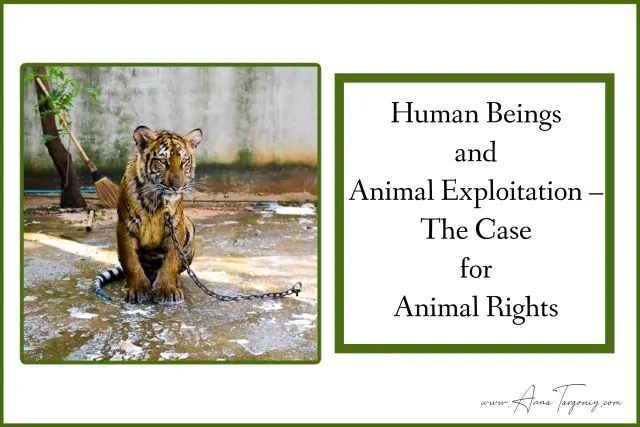Human Beings and Animal Exploitation – The Case for Animal Rights
Table of Contents
Relationships between animals and humans have always been complicated. Since the beginning of the human race, humans have used animals as their property (food, clothes, decoration, trophies, tamed hunters, guards, pets and other). With time, human intellect has increased, but the way we treat animals has become worse.
Along with the initial ways humans used animals, people also started to exploit innocent animals in lab testing, trophy hunting tourism, breeding animal hybrids for fur and zoo shop industries, using animals in entertainment spheres (circus, zoos, petting zoos, photo shoots, and others), along with stealing rare animals from their natural habitats for use as pets.
Humans have used animals so much that they began doing cruel and inhuman manipulations with animals to make their meat taste better, or fur stay “fresher” after it was removed. Although the majority of people might think that animals are different from humans, it isn’t entirely valid.
Animals do have emotions and feelings similar to human ones, not only instincts, as we often think.
Every living creature should have rights to live their lives safe from exploitation, and humans should not have rights to harm innocent lives for their needs!
Animal Testing in Scientific, Medical, and Laboratory Research
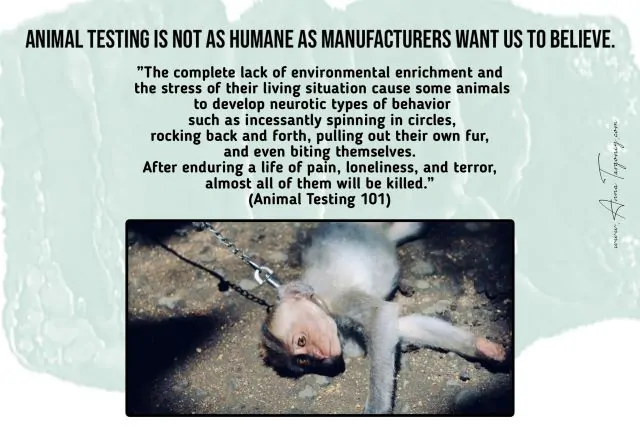
For hundreds of years, animals have been used as testing subjects for scientific and medical research for human purposes. However, occasionally, humans have made steps to limit the cruelty towards animals- even if it is not yet enough.
In the United States, the Animal Welfare Act sets specific minimum requirements for the humane treatment of non-human animals in laboratories and other settings. The Animal Welfare Act was signed into law by President Lyndon Johnson in 1966.
The law, according to the U.S. Department of Agriculture, sets
“minimum standards of care and treatment be provided for certain animals bred for commercial sale, used in research, transported commercially, or exhibited to the public.” (Animal Rights and The Ethics of Testing)
However, anti-testing advocates believe that this law has limited enforcement power. For example, the AWA doesn’t protect rats and mice from testing (what is approximately 95 percent of all animal testing).
Although, while “the fight” for freeing animals from testing in the United States is ongoing, the same “war” has ended on the animals’ side in the European Union. The European Union banned animal testing for cosmetic purposes in 2013, and on November 20, 2018, they fully banned the entire animal testing industry. (Euractiv)
In the United States, only four states have banned animal testing for cosmetic purposes.
The first state which prohibited animal testing for cosmetics and personal care items was California (2002), the second to join was New Jersey (2007), then New York (2014), and in 2018 the ban was made in Virginia. (State Laws)
The European Union isn’t the only group of countries which entirely banned animal testing for cosmetic purposes; others include India, Israel, and New Zealand. Meanwhile, in the United States, every year over 100 million animals suffer due to cruel toxic, drug, cosmetic, food, medical training exercises and medical experiments at universities.
Examples of animal testing including force-feeding dogs pesticides, forcing rates and mice to inhale toxic fumes and dripping corrosive chemicals to rabbits eyes. The worst part about this animal abuse is that none of these experiments are actually helpful for humans. Even if the tests showed that products were harmful to animals, there is still a big chance that they will be approved for humans.
On the other hand, if a product was marked safe for animals, it’s still doesn’t guarantee that it will be safe for humans. There are plenty of non-animal testing alternatives which are potentially cheaper, quicker, and more relevant for humans.
Animal testing is not as humane as manufacturers want us to believe.
”The complete lack of environmental enrichment and the stress of their living situation cause some animals to develop neurotic types of behavior such as incessantly spinning in circles, rocking back and forth, pulling out their own fur, and even biting themselves. After enduring a life of pain, loneliness, and terror, almost all of them will be killed.” (Animal Testing 101)
Not many people know, but the United States taxpayer’s money often funds the animals used in toxicity tests. According to PETA,
“The federal government and many health charities waste precious dollars from taxpayers and well-meaning donors on animal experiments at universities and private laboratories, instead of supporting promising clinical, in vitro, epidemiological, and other non-animal studies that could actually benefit humans.”
Animal Abuse in the Food and Fur Industries
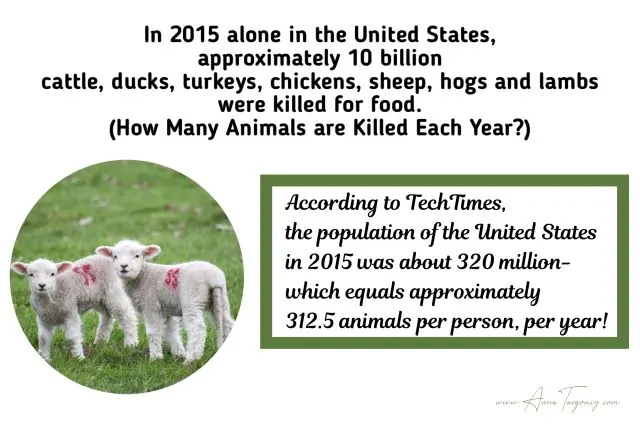
In 2015 alone in the United States, approximately 10 billion cattle, ducks, turkeys, chickens, sheep, hogs and lambs were killed for food. (How Many Animals are Killed Each Year?)
According to TechTimes, the population of the United States in 2015 was about 320 million- which equals approximately 312.5 animals per person, per year!
All of this does not even consider fish and marine animals, which people continue to take from oceans and other water sources. This number as well doesn’t contain information about wild animals killed by hunters, wildlife displaced by animal agriculture, and wildlife killed by farmers pesticides, traps and other methods.
Furthermore, every year approximately 40 million animals die worldwide because of the fur industry. This statistic includes about 30 million animals killed in fur factories, about 10 million killed in the wild by traps, and hundreds of thousands of seals killed for fur.
This statistic doesn’t include unwanted “trash” animals, which were killed by traps or seals who are injured, and escape and died later.
If you think that at least the animals are “stored” in humane conditions or killed without pain, that isn’t true. Animals have feelings, and they fully understand that they are being raised for killing, as well as they understand when their family and other animals are killed in front of them. Animals are often placed in tiny cages where their muscles atrophy because they never walk.
From some kinds of animals (like chinchillas), fur is removed from their bodies while they are alive, which helps it to stay “fresher.” It takes approximately 150 chinchillas to make a fur coat, and it’s with the fact that chinchillas are classed as a vulnerable species by the International Union for Conservation of Nature and Natural Resources. (Wikipedia)
Currently, there only an estimated 10,000 individual chinchillas in the Chilean mountains, and they are still often used to make fur coats. (Chinchilla – Animal Corner)
Animal Exploitation in Entertainment Industries
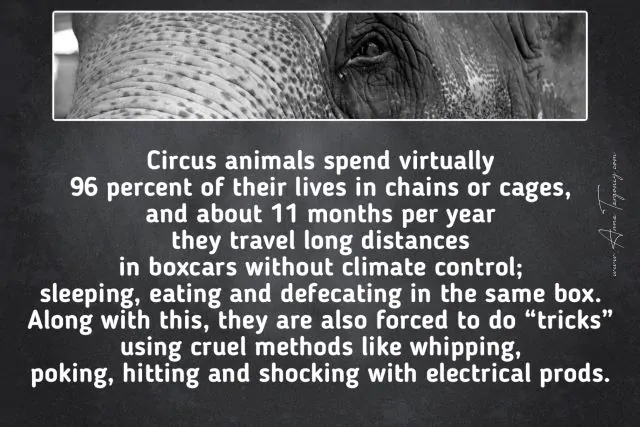
One of the biggest paradoxes about the animal entertainment industries that it isn’t entertaining for animals. All we see on the circus stages are the results of inhuman and cruel conditions in which people are putting animals.
Circus animals spend virtually 96 percent of their lives in chains or cages, and about 11 months per year they travel long distances in boxcars without climate control; sleeping, eating and defecating in the same box. Along with this, they are also forced to do “tricks” using cruel methods like whipping, poking, hitting and shocking with electrical prods. (Enjoy the Circus? The Animals Don’t)
While zoo industries have two sides, most of the United States Zoos (including SeaWorld and aquariums) use only rescued endanger animals which are unable to survive in the wild, as well as using their profits to help even more animals in the wild. According to Scientific American,
“To wit, dozens of zoos across North America participate in the Association of Zoos and Aquarium’s (AZA’s) Species Survival Plan (SSP) Program, which aims to manage the breeding of specific endangered species in order to help maintain healthy and self-sustaining populations that are both genetically diverse and demographically stable.”
Even by visiting zoos in the United States and the European Union you can clearly see that the animals in these zoos are raised in good conditions and satisfied with their lives- which you can’t tell about zoos in most other countries. Across the world, animals suffer from zoo industries. Animals are held and raised in terrible conditions, fed the wrong diet, abused and shocked.
The World Association of Zoos and Aquariums (Waza) has created some of the worst conditions for its animals.For example, Zoo Negara in Malaysia has been condemned for its terrible conditions.
Another zoo, the Dehiwala Zoo in Sri Lanka has been noted for bad conditions after the deaths of a hippo, a lion and every single one of the zoo’s penguins. Furthermore, the zoo has also been criticized for elephant shows, in which the handlers threaten the animals to make them do tricks. (World’s Leading Zoo Association Accused of Overlooking Horrific Cruelty)
More instances include when a manacled performing elephant was filmed at the Dusit Zoo in Bangkok, and in the Almaty zoo in Kazakhstan and the National Taiwan Aquarium where each zoo respectively has been accused of housing bears and beluga whales in sub-standard living conditions.
One of the more famous and disgusting “zoo events” seen throughout the world was in 2009 when a South Korean TV show filmed a small, terrified bear being placed inside a tiger enclosure at Everland Park.
Improving the Conditions of Animal Lives – How Can You Help?
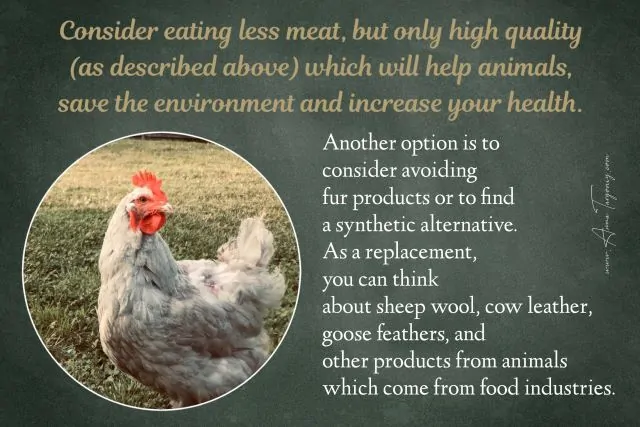
Before anything else, people need to stop using animals as their property. Animals must have rights to live a safe life without being exploited for human beings. There are multiple ways we can support the animals’ rights movement without completely changing our lives.
For example, we should consider eating grass-fed beef from local farmers, cage-free chickens, and eggs. This will give you a warranty that the animals were living their lives without struggling in tiny cages and just waiting to be killed.
Also, doing this will provide you with an abundant amount of nutrients which are lost because of the poor diet and inadequate living conditions of animals, and you don’t need to be worried about added antibiotics and hormones.
Consider eating less meat, but only high quality (as described above) which will help animals, save the environment and increase your health.
Another option is to consider avoiding fur products or to find a synthetic alternative. As a replacement, you can think about sheep wool, cow leather, goose feathers, and other products from animals which come from food industries.
Choosing these animals means that the whole animal will be used at one time, and there is no need to kill extra animals.
An easy step is not to support circuses! Never buy tickets to circuses which are using animals in their shows.
Also, support only zoos and aquariums which are using rescued animals and using their profits to help animals.
Lastly, buy only cruelty-free cosmetics products and supplements. Don’t support animal testing by any chance! Don’t think that your choice will change nothing because every time you are buying animal-tested products think about how much is your “beauty” worth in animals’ lives!
It is not difficult for humans to live without exploiting animals, and the steps to improve our current situation are not difficult to make!
Read Next: Fast Fashion Brands to Avoid – How H&M, GAP and Zara are Killing the World

